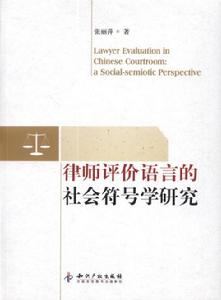基本信息
書名:律師評價語言的社會符號學研究
作者:張麗萍
出版社:智慧財產權出版社
ISBN:978-7-5130-0685-9/D (3579)
出版時間:2011-11
版次:第一次印刷
開本:16開
頁數:204頁
圖書分類:法律| 學術著作
定價:39元
內容簡介
 圖書封面
圖書封面本書運用語言學理論來探討法律交際領域中的具體問題,具有跨學科研究性質,涉及語言學、哲學、法學等學科知識,體現了套用語言學的社會實踐價值,因此不僅對法律語言學、話語分析、套用語言學等專業的研究人員與學生有啟發意義,對從事司法實踐或研究法學文化的學者或學生也有實踐參考價值,也合適做英語、法律愛好者的閱讀材料。
讀者對象法律語言學、話語分析、套用語言學等專業的研究人員與學生以及從事司法實踐或研究法學文化的學者或學生。
作者簡介
張麗萍,女,生於1973年11月1日,山西和順人,南京理工大學外國語學院教師,副教授,碩士生導師,廣東外語外貿大學套用語言學博士,法律語言學方向首批博士生。迄今為止,已發表各類法律語言學論文十餘篇(其中CSSCI四篇),參加國際學術會議一次,主持或參與省廳/部級科研項目10項,參與校精品課程建設3項,承擔或參與校教改項目2項,參與教材編撰2部。
目錄
Contents
1 Introduction 1
1.1 Research orientation 2
1.2 Working definition 4
1.3 Rationale for this study 5
1.4 Objective and research questions 7
1.4.1 General objective 7
1.4.2 Specific research questions 7
1.5 Significance of this study 8
1.6 Research methodology and data collection 9
1.6.1 Research methodology 9
1.6.2 Data collection and description 9
1.7 Organization of this thesis 10
2 Literature Review 12
2.1 Introduction 12
2.2 The construct of lawyer evaluation 12
2.2.1 The origin of lawyer evaluation 12
2.2.2 The constituents of lawyer evaluation 14
2.3 Lawyer evaluation and context 16
2.4 Lawyer evaluation in context: a linguistic perspective 22
2.4.1 Lawyer evaluation identified in discourse 23
2.4.2 Two dimensions for the positioning of lawyer evaluation 29
2.4.3 Lawyer evaluation on the dimension of solidarity 30
2.5 Lawyer evaluation in context: a legal perspective 36
2.5.1 Major issues for lawyer evaluation 36
2.5.2 Predominant legal ideology 37
2.5.3 Habermasian interpretations of judicial communication 40
2.6 Summary 43
3 Theoretical Framework 45
3.1 Introduction 45
3.2 Lawyer evaluation, context and the dispute resolution 45
3.2.1 Socio-semiotic view of language 46
3.2.2 Constituents of lawyer evaluation 46
3.2.3 Legal contexts as determinants 53
3.2.4 The presentation of lawyer evaluation 59
3.2.5 Functions of lawyer evaluation in the trial 63
3.3 The theoretical framework 65
3.4 Summary 70
4 The Constituents of Lawyer Evaluation 72
4.1 Introduction 72
4.2 Lawyer evaluation as Affect 73
4.3 Lawyer evaluation as Judgement 76
4.3.1 Social Esteem 77
4.3.2 Social Sanction 79
4.3.3 Social Punishment 82
4.4 Lawyer evaluation as Appreciation 85
4.4.1 Reaction 85
4.4.2 Composition 88
4.4.3 Valuation 90
4.5 Summary 93
5 Lawyer Evaluation under Contextual Constraints 94
5.1 Introduction 94
5.2 Lawyer evaluation under constraints from the situational context 94
5.2.1 The situational context and its constraints 95
5.2.2 Lawyer evaluation in confrontation 95
5.3 Lawyer evaluation under the situation of culture 106
5.3.1 Habermasian law and rational confrontation 106
5.3.2 Lawyer evaluation in rational confrontation 108
5.4 Summary 117
6 Discursive Construction of Rational Lawyer Evaluation 118
6.1 Introduction 118
6.2 Equal role relationship 119
6.2.1 Underlining the Common Ground 119
6.2.2 Highlighting judicial knowledge 123
6.3 Multi-voiced discourse environment 126
6.3.1 Projection 127
6.3.2 conjunctive adjuncts 131
6.3.3 Dialogical comment adjuncts 132
6.4 Diverging discursive community 134
6.4.1 Positive evaluation 135
6.4.2 Negative evaluation 138
6.4.3 Graded evaluation 141
6.5 Summary 145
7 Functions of Lawyer Evaluation 147
7.1 Introduction 147
7.2 Negotiating the determinacy in case facts 147
7.2.1 Scaling the case presentation 148
7.2.2 Graded judgment of case facts 154
7.3 Negotiating the categorical boundary in alleged charges 158
7.3.1 The interpretation of relevant legal rules 159
7.3.2 Prototypicality in legal charges 162
7.4 Negotiating the degree of law application 165
7.4.1 The selection of a specific rule 166
7.4.2 The degree of law application 168
7.5 Summary 169
8 Conclusion 171
8.1 Summary of the previous chapters 171
8.2 Major findings and conclusions 172
8.2.1 Major findings 172
8.2.2 Conclusions 173
8.3 Implications 175
8.3.1 Theoretical implications 175
8.3.2 Practical implications 177
8.4 Limitations 179
8.5 Suggestions for further study 179
APPENDICES 181
Appendix 1 Transcription notations 181
Appendix 2 Selected Trial Transcripts 183
Appendix 3 Article 5 of the Law of Unfair Competition 189
REFERENCES 190
後記204
